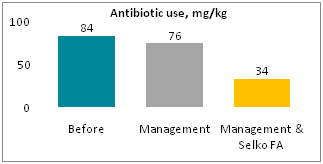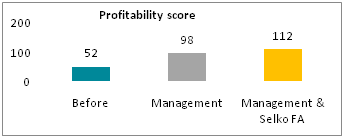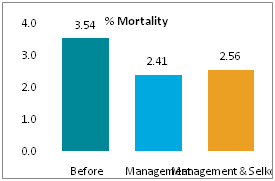By Dr.Ashok Rajguru, Program Manager, Trouw Nutrition India
Poultry Industry faces disease challenges from viral, bacterial and protozoal sources which contribute significantly to economic losses in poultry production. For controlling bacterial infections, AGP and antibiotics are the common remedies which in turn leads to AMR. AMR (Anti-microbial resistance) refers to antimicrobial adaptation of a microorganism (bacteria, viruses, fungi, protozoa and helminths) to which it was previously sensitive. It is estimated that every year at least 700,000 deaths are attributable to AMR. Given the current rate, the annual death toll can climb to 10 million by 2050. Given the rapid zoonotic prevalence, AMR bacteria may also spread from animals to their environment and to humans. That’s why World Health Organization (WHO) in 2017 has recommended to stop rampant usage of antimicrobials for growth promotion purpose. As a response to AMR reduction, Asian regions like India, China, Indonesia, and Vietnam banned use of Colistin as a feed additive (growth promoter). By limiting the use of antimicrobials, poultry producers can help to maintain the efficacy of these interventions, protecting animals’ health and humans. Trouw Nutrition’s global experience in working with integrators who are leaders in antibiotic reduction have demonstrated that it is possible to produce broilers without antibiotics and realize improved health performance of chicken withbetterprofitability.
A successful AMR reduction requires a systematic integrated approach. Trouw Nutrition’s Feed-Farm Health programme has been effectively demonstrated (Figure 1,2,3&4) to reduce the reliance on antibiotics and eventually result in an antibiotic-free rearing.

Fig.1 Feed, Farm & Health intervention reduced Antibiotic use (-59%)

Fig.2 Feed, Farm & Health intervention improved profitability
Fig. 3 & 4 – Feed, Farm & Health additive intervention reduce FCR (-5%) & mortality (-28%)
This programme includes analysis of critical control points across entire poultry production chain. Analysis of each component in the chain can be tailor-made solution designed to address each producers’ situations. This integrated approach underlines Trouw Nutrition’s commitment to help customer reduce need for antibiotics while maintaining profitability. This tailor-made intervention helps to overcome challenges while reducing antibiotics usage. Thesix steps approach mentioned ahead will help to achieve high performing flocks without the use of antibiotics.
Step 1: Define the purpose of AMR reduction:
First define the purpose of antibiotic reductionprogramme, for e.g., farming without antibiotics, reducing antibiotics or stop only AGP. Successful antibiotic reduction requires commitment across the production chain. Trouw Nutrition believes that defining and believing in the purpose is an important step before designing the tailor-made programme as per customer requirements.
Step2: Auditfeed,farm,healthbaselines:
Measuringprogressrequiresestablishingabenchmarkforcomparison. There are certain parameters to be evaluated at the level of feed,farmandhealth.
Feed Management:
Consider the breed (RossorCobb), whenevaluatingfeedintakeandfeedingschedule. Some information should be collected such as feed form, daily feed intake by chicks/birds. Also, we should collect feed samples & RM and conduct feed analysisfor nutritional, mycotoxins and microbial analysis such as moulds, bacteria (Enterobacteriaceae). If thresholds are exceeded, accordingly action will be taken in term of feed formulation, feed safety measures such as microbial and mycotoxin control programme.
Farm Management:
Day-old chicks are vulnerable, so check newly arrived chick quality, including weight uniformity and body temperature. Consider the climate of the chick house. Evaluate proper brooding temperature, floor temp, correct ventilation, proper feeder and water drinker arrangement and easy access of it to chicks. We should consider aspects like sufficient paper feeding, hygienic floor andbiosecurity etc. while auditing farm.
Health Management:
It is important to know currently which antibiotics are being used and for what purpose. Effectiveness of the antibiotics should be assessed along with other details like if any antibiogram is done and if there is a customized anticoccidial rotation programme in place. Review current vaccine schedule and feed & water acidifier being used, if any. Evaluate dropping consistency, necrotic enteritis or dysbiosis status. Conduct gut lesion scoring for dysbacteriosis, coccidiosis and gizzard scoring.
Step 3. Introduce tailor made solutions
Only after an audit (preferably after completion of production chain) targeted solutions should be introduced. Following products, models and services can be implemented.
Feed Management:
Solutions should be able to assess the current nutritional parameters and accordingly provide the best solutions for precision nutrition while also assessing and managing the risk of microbes. At Trouw Nutrition, we incorporate high quality least cost feed formulation and conc. premixes to meet optimum nutritional requirements, models like NutriOptincluding NOA and NIR services for rapid nutritional feed analysis and precision nutrition. Feed safety programme of Trouw Nutrition helps to mitigate mycotoxin risk and microbial contamination through Toxo XL,Fysal MP/Selacid GG depending on risk assessment review.
Farm Management
With 90 years of global expertise, Trouw Nutrition provides services like advice on house climate, positioning of feeders, feeding pattern, and water drinking according to age of birds and other environment challenges control etc. In addition to control water infection and for better digestion an effective water acidifier like Selko-pH can be introduced.
Health Management
For overall good animal health, ensuring good gut health is a primary challenge. Trouw Nutrition’s 5-pillar approach (Fig 5) for ensuring eubiosis through a strategic use of synergistic combinations helps to achieve the desired health status. Products like Selko pH, Selacid GG, Presan-FY and IntelliBond C can support in ensuring healthy life. In addition, our gut health experts can help in dysbacteriosis gut health scoring, provide advice on vaccination &biosecurity.

Figure 5: Trouw Nutrition’s 5 pillar to support gut health
Step 4: Calculate Return on Investment (ROI)
A solid AMR strategy must also make sense in terms of efficacy and producer economics. It is important to assess the same in regular intervals while also ensuring that there is a systematic approach in achieving the final objective.
Step 5: Implementation is key point
Continuous collaboration, sharing of information and communication between the various stakeholders is essential to ensure the desired results. Trouw Nutrition with the help of regional and global experts ensures the maximum knowledge sharing to meet our customer’s requirements.
Step 6: Evaluate, Adapt, Repeat AMR programme
Finally, we assess whether the implemented intervention meets the customer’s need as outlined in step 1. The process is repeated until the final goal is achieved. In a dynamic market- place, the initial goal will inevitably be fine-tuned over time. Consistently deploying a six-step cycle which integrates feed, farm and health management, can take AMR programme from vision to achievement.
Conclusion:
Trouw Nutrition is committed toenable the animal production industry to reduce the need for antibiotics while maintaining profitability and we already have a track record of being capable in doing so.
For further information, kindly write to us at customercareindia@trouwnutrition.com or visit our website: www.trouwnutrition.in

